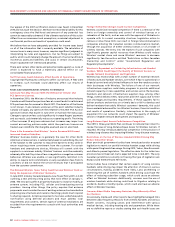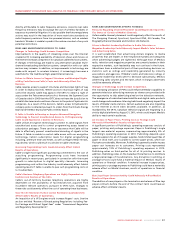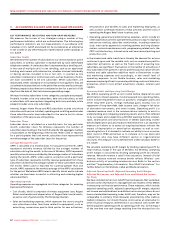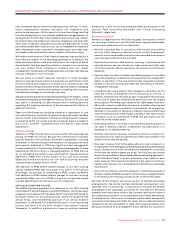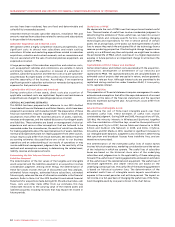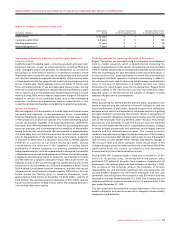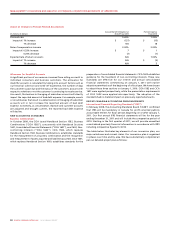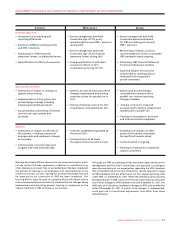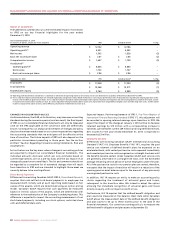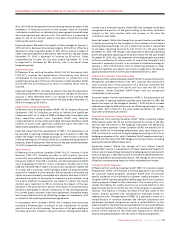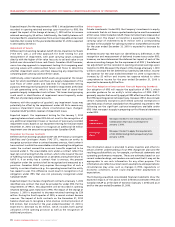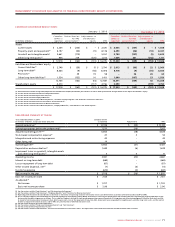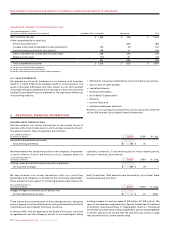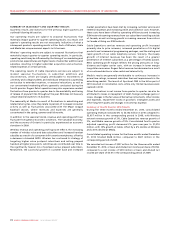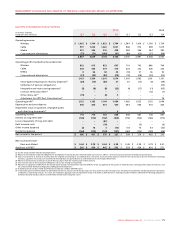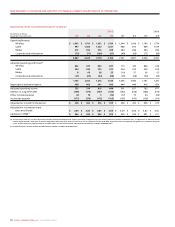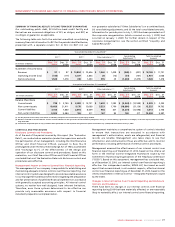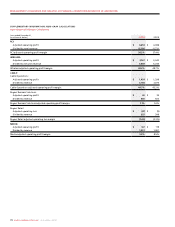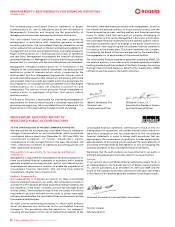Rogers 2010 Annual Report Download - page 66
Download and view the complete annual report
Please find page 66 of the 2010 Rogers annual report below. You can navigate through the pages in the report by either clicking on the pages listed below, or by using the keyword search tool below to find specific information within the annual report.
MANAGEMENT’S DISCUSSION AND ANALYSIS OF FINANCIAL CONDITION AND RESULTS OF OPERATIONS
70 ROGERS COMMUNICATIONS INC. 2010 ANNUAL REPORT
Other impacts
Private investments: Under IFRS, the Company’s investments in equity
instruments that do not have a quoted market price must be measured
at fair value. Under Canadian GAAP, these instruments are measured at
historical cost. The impact on transition is expected to increase the
carrying value of investments by $1 million with a corresponding
increase to the available-for-sale equity reserve. Comprehensive income
for the year ended December 31, 2010 is expected to decrease by
$2 million.
Deferred Income Tax: We have not identified any differences in the
recognition and measurement of deferred income taxes under IFRS;
however, we have determined the deferred tax impact of each of the
above accounting changes. Per the requirements of IFRS 1, the deferred
tax adjustment will be recorded in opening retained earnings upon
transition to IFRS. We expect the impact of the change at January1,2010
will be to decrease the net deferred tax liability by $34 million. Income
tax expense for the year ended December 31, 2010 is expected to
increase by $2 million and income tax expense related to other
comprehensive income for the year ended December 31, 2010 is
expected to decrease by $20 million.
First-Time Adoption of International Financial Reporting Standards
Our adoption of IFRS will require the application of IFRS 1, which
provides guidance for an entity’s initial adoption of IFRS. IFRS 1
generally requires that an entity apply all IFRS effective at the end of its
first IFRS reporting period retrospectively. However, IFRS 1 does include
certain mandatory exceptions and limited optional exemptions in
specified areas of certain standards from this general requirement. The
following are the significant optional exemptions available under
IFRS1 that we expect to apply in preparing our first financial statements
under IFRS.
Business
Combinations
We expect to elect to not restate any Business
Combinations that have occurred prior to
January 1, 2010.
Borrowing
Costs
We expect to elect to apply the requirements
of IAS 23 Borrowing Costs prospectively from
January 1, 2010.
The information above is provided to allow investors and others to
obtain a better understanding of our IFRS changeover plan and the
resulting possible effects on, for example, our financial statements and
operating performance measures. These are estimates based on our
current understandings, and readers are cautioned that it may not be
appropriate to use such information for any other purpose. This
information also reflects our most recent assumptions and expectations;
circumstances may arise, such as changes in IFRS, regulations or
economic conditions, which could change these assumptions or
expectations.
The following unaudited consolidated financial statements show the
expected impacts of the above noted differences between IFRS and
Canadian GAAP as at the date of transition (January 1, 2010) and as at
and for the year ended December 31, 2010.
Expected impact: Per the requirements of IFRS 1, this adjustment will be
recorded in opening retained earnings upon transition to IFRS. We
expect the impact of the change at January 1, 2010 will be to increase
retained earnings by $4 million. Additionally, the liability balance will
be reclassified to unearned revenue from accounts payable and accrued
liabilities. Net income for the year ended December 31, 2010 is expected
to decrease by $3 million.
Impairment of Assets
Differences from existing Canadian GAAP: IAS 36, Impairment of Assets
(“IAS 36”), uses a one-step approach for both testing for and
measurement of impairment, with asset carrying values compared
directly with the higher of fair value less costs to sell and value in use
(which uses discounted future cash flows). Canadian GAAP however,
uses a two-step approach to impairment testing: first comparing asset
carrying values with undiscounted future cash flows to determine
whether impairment exists; and then measuring any impairment by
comparing asset carrying values with fair values.
Additionally, under Canadian GAAP assets are grouped at the lowest
level for which identifiable cash flows are largely independent of the
cash flows of other assets and liabilities for impairment testing
purposes. IFRS requires that assets be tested for impairment at the level
of cash generating units, which is the lowest level of assets that
generate largely independent cash inflows. This lower-level grouping
could result in identification of impairment more frequently under
IFRS, but of potentially smaller amounts.
However, with the exception of goodwill, any impairment losses may
potentially be offset by the requirement under IAS 36 to reverse any
previous impairment losses where circumstances have changed.
Canadian GAAP prohibits reversal of impairment losses.
Expected impact: Our impairment testing for the January 1, 2010
opening balance sheet under IFRS did not result in the recognition of
any additional impairment losses or reversals of previously recorded
impairment losses. Based on our impairment testing for the year ended
December 31, 2010, we expect to recognize an additional $5 million
impairment over the amount recognized under Canadian GAAP.
Provisions for Onerous Contracts
Differences from existing Canadian GAAP: IAS 37 Provisions, Contingent
Liabilities and Contingent Assets (“IAS 37”), requires an entity to
recognize a provision when a contract becomes onerous, that is when it
has a contract in which the unavoidable costs of meeting the obligations
under the contract exceed the economic benefits expected to be
received under it. The unavoidable costs under a contract reflect the
least net cost of exiting from the contract, which is the lower of the cost
of fulfilling it and any compensation or penalties arising from failure to
fulfill it. If an entity has a contract that is onerous, the present
obligation under the contract shall be recognized and measured as a
provision. Canadian GAAP only requires the recognition of such a
liability in certain situations (e.g. for operating leases that the entity
has ceased to use). This difference could result in recognition of an
obligation under IFRS that was not previously recognized under
Canadian GAAP.
Expected impact: Our review of significant contracts at January 1, 2010
identified one contract that must be provided for under IFRS. Per the
requirements of IFRS 1, this adjustment will be recorded in opening
retained earnings upon transition to IFRS. The impact of the change at
January 1, 2010 is expected to decrease retained earnings by $29
million. During the fourth quarter of 2010, a second contract became
onerous. The impact of both contracts on the December 31, 2010
balance sheet was to recognize a total onerous contract provision of
$35 million. Net income for the year ended December 31, 2010 is
expected to decrease by $6 million, which includes both partial
utilization of the opening provision as well as the recognition of
additional provisions.


